Of the many species of carnivorous plants that inhabit our world, sundews are my favorites. They trap their insect diet with a carpet of short glands with sticky tips that grow from the surface of their leaves. The glue-like substance at the tips of these glands glistens in the sun, giving these plants their common name – sundews.
It is not hard to see how effective this trap is by taking a close look at the leaves. It may be a tad morbid, but little black and brown bodies of small and sometimes larger insects come into view. These trapped insects are often twisted in odd positions, the results of initial struggles to free themselves, only to become more entangled by the glue – botanical flypaper.

In addition to sticky glue, these glands produce nectar to attract prey. Once trapped by the strong adhesive, leaves often begin to curl (a chemical reaction) that creates a more humid chamber where enzymes begin the process of digestion. Released nutrients are absorbed by the leaf. Unlike the active leaf traps of Venus Flytraps, this action is much slower in sundews, as the prey is already trapped.
In south Mississippi, there are at least four species of sundews that inhabit wet pine forests, wet pine savannas, and the edges of ponds and bogs. Of these, the small, circular-shaped, ground-hugging species are the most common. In Wet Pine Savannas, Pink Sundews (Drosera capillaris) can be numerous across bare soil, creating a glistening red carpet of plants. Their light pink flowers appear on slender stalks in early to late spring, rising above a circular-shaped cluster of spoon-shaped leaves.
Dwarf Sundew (Drosera brevifolia) has a similar plant shape, occurring in moist soils of pinelands and sandy roadsides and bogs. As with its close relative, small white to pale pink flowers appear in late spring, making them easier to spot. Spoonleaf Sundew (Drosera intermedia) is a much larger plant that rises above the soil in multiple branches with longer, spoon-shaped leaves. It can be found along the edges of small ponds and bogs.
The largest of our local sundews is Threadleaf Sundew (Drosera tracyi). As its name suggests, its leaves are long and slender, rising upwards of 8-12 inches. They unfurl much like the fronds of ferns as they emerge in spring. Inhabiting wet pine savannas and wet roadside bogs and ditches, these plants become obvious as their long leaves glisten on a sunny day. Light pink flowers emerge in spring.
Apart from sundews, Butterworts also trap insects in a sticky substance that covers the surface of their larger leaves forming a cluster of leaves near the ground. The sticky substance has the consistency of butter when rubbed between two fingers. Coastal Mississippi is home to at least three species, one with bright yellow flowers, and the others with lavender to blue blossoms.
You have to wonder where the inventor of flypaper got their idea. Perhaps it was inspired by an encounter with the botanical sticky traps we call sundews. These cool plants can be seen along the nature trails of the Mississippi Sandhill Crane Refuge – the Dees Trail at the refuge headquarters near Gautier and the Fontainebleau Trail in Ocean Springs.
Hope to see you in our great outdoors.
Photos by Mark W. LaSalle